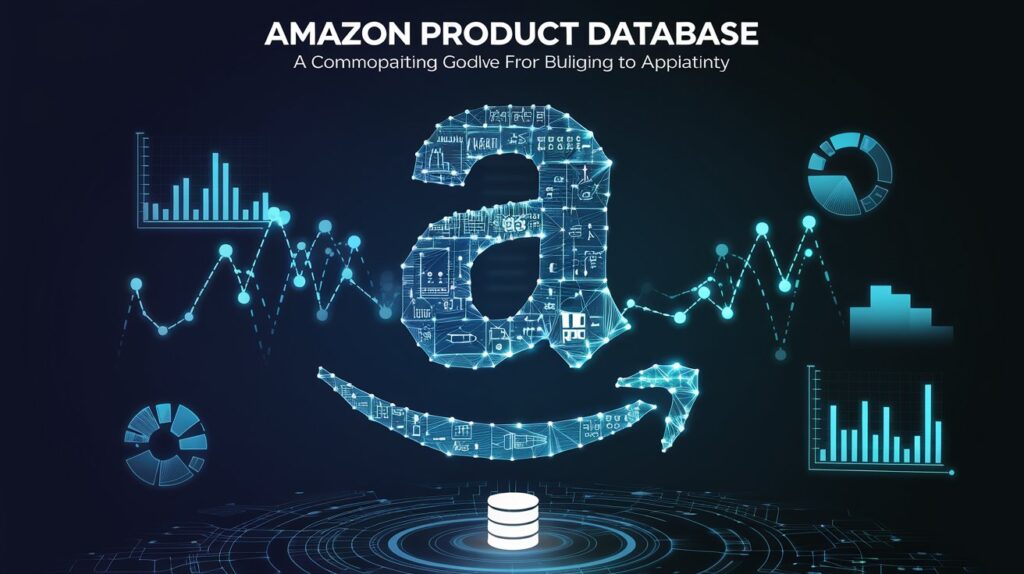Introduction
In today’s fiercely competitive e-commerce landscape, data-driven decision-making has become crucial for success. The Amazon product database, as a core asset in e-commerce operations, provides invaluable market insights and analytical foundations for businesses.
Importance of the Amazon Product Database
As the world’s largest online retail platform, Amazon’s product data holds immense commercial value. Establishing an efficient product database is not just about data storage; it’s about enabling in-depth analysis and business intelligence. By mining Amazon’s product data, companies can gain insights into market trends, consumer preferences, and competitive environments, allowing them to formulate more targeted strategies. Particularly in the rapidly changing e-commerce market, real-time product data updates enable companies to swiftly respond to market changes and avoid missing business opportunities.
The Role of Data-Driven Decision Making in E-Commerce
In e-commerce, data-driven decision-making means relying on real-time data to guide business strategies. By analyzing consumer purchasing behaviors, browsing histories, and feedback, companies can better understand the needs and preferences of their target customers. This not only helps optimize inventory management and reduce capital occupancy but also enhances conversion rates. For instance, leveraging data analysis allows businesses to predict which products will gain popularity in the future, enabling them to stock up in advance. Additionally, data-driven decision-making can enhance a company’s competitive edge, maintaining flexibility and adaptability in a complex market environment.
Basics of the Amazon Product Database
2.1 What is the Amazon Product Database?
The Amazon product database is a systematic collection of data that includes various information related to products on the Amazon platform, such as product descriptions, prices, inventory status, and sales figures. This database serves not only as a foundational resource for merchants seeking data but also as a critical tool for market analysis, customer management, and marketing strategy formulation. By integrating various product data, companies can quickly access the information they need and conduct in-depth analyses to gain comprehensive market insights.
2.2 Core Data Field Analysis
When constructing the Amazon product database, several core data fields are essential:
- Product ID: A unique identifier for each product. The Product ID serves as the basis for data association and queries.
- Product Name: The name and description of the product, often containing keywords. This field directly affects SEO optimization and user search experience.
- Price: The current selling price and historical price trends of the product. Changes in price data reflect market supply and demand dynamics, crucial for dynamic pricing and competitive analysis.
- Inventory Status: Reflects the availability of the product. Inventory data is vital not only for sales strategies but also for user satisfaction and purchasing decisions.
- Customer Reviews: Consumer ratings and feedback on products. Customer reviews provide direct insights into product quality and help businesses understand market demand and customer expectations.
- Sales Rank: The sales ranking of the product within its category. This data quickly reflects a product’s market performance, helping merchants identify bestsellers and potential competitors.
2.3 Database Structure Design Considerations
Designing an efficient database structure involves several factors, including data relationships, indexing optimization, and query efficiency. Common database design patterns include relational databases and document-oriented databases. The choice of the appropriate database type depends on the specific application scenario. For example, for frequently queried and associated data, relational databases like MySQL or PostgreSQL are preferable, whereas document-oriented databases like MongoDB are more suitable for flexibly storing unstructured data. Moreover, data redundancy and integrity must be considered in the design to ensure the database maintains performance stability under high load.
Methods for Building the Amazon Product Database
3.1 Manual Collection: Pros and Cons
Manual data collection methods are straightforward but time-consuming and prone to errors. They are suitable for small-scale product database construction, particularly in initial stages or for specific research purposes. However, for large-scale data collection, manual methods not only consume time but are also significantly affected by human factors. By collecting data manually, merchants can perform in-depth analyses of specific products, but in resource-constrained situations, achieving a global perspective is often challenging. Thus, when determining the data collection strategy, it’s essential to consider the project’s scale and long-term goals.
3.2 API Integration: Official Channels and Limitations
Using Amazon’s provided APIs can efficiently obtain product data, but the access limitations and call frequency of the API can impact the timeliness and completeness of the data. Merchants need to register for a developer account and understand the API documentation, mastering how to authenticate, set request parameters, and process returned data. Additionally, Amazon’s API typically has limitations on call frequency, which may become a bottleneck for large-scale data collection. Therefore, companies must develop a reasonable API calling strategy to maximize data acquisition without violating regulations.
3.3 Web Crawlers: Technical Challenges and Solutions
Web crawlers are a common method for obtaining data. By writing crawler programs, developers can automatically scrape large amounts of product data. However, anti-scraping mechanisms and the complexity of website structures can pose challenges. Solutions include using proxy services, adjusting request frequencies, and employing dynamic rendering tools like Selenium and Playwright. These tools can simulate user behavior to bypass simple anti-scraping measures. Additionally, regularly updating the crawler program to adapt to changes in website structures is crucial for successful data scraping.
3.4 Third-Party Data Services: Balancing Efficiency and Cost
Third-party data service providers, such as Pangolin Data Services, can quickly provide high-quality product data. Companies need to balance efficiency and cost when selecting suitable services to meet their needs. By using third-party services, businesses can save development time and leverage professional technology to obtain higher quality data. However, when choosing a data service provider, merchants should evaluate the accuracy, update frequency, and cost of the data to ensure the best return on investment.
Managing and Maintaining the Amazon Product Database
4.1 Data Update Strategies
Maintaining an effective product database requires regular data updates. It is advisable to establish a data update strategy that includes daily, weekly, or monthly update frequencies to ensure the timeliness of the data. Additionally, companies should consider dynamic changes in data, such as promotional activities and price adjustments, ensuring that the database can reflect market conditions in real time. Utilizing automated scripts and scheduled tasks can significantly reduce the workload of manual maintenance, enhancing the efficiency and accuracy of data updates.
4.2 Data Quality Control
Data quality directly affects analytical results. Therefore, establishing a data quality control mechanism, including data validation, cleaning, and deduplication, is vital to ensuring the accuracy of the database. By setting data validation rules and automating the detection of anomalies and errors in the data, issues can be identified and rectified promptly. Moreover, conducting regular data audits and quality assessments helps maintain high standards for the database, ensuring that all analyses are based on reliable data.
4.3 Data Storage and Scalability Considerations
Choosing the right database storage solution is critical. For large-scale data, consider using distributed databases to allow for on-demand expansion of storage capacity and processing power. Cloud database services like Amazon RDS and Google Cloud SQL provide flexible storage solutions that support quick data expansion and access. Furthermore, when designing the database architecture, sufficient space for future expansion should be reserved to accommodate changing data requirements due to business growth.
Utilizing the Amazon Product Database for Business Analysis
5.1 Price Trend Analysis
By analyzing price data, companies can identify market dynamics and changes in pricing strategies. Using historical data to forecast future price trends aids businesses in optimizing their pricing strategies. Specifically, price trend analysis can help merchants identify the best promotional timing, adjust product pricing to enhance sales, and optimize advertising strategies. Using visualization tools to convert data into graphs can present price fluctuations more intuitively, enabling decision-makers to quickly grasp market changes.
5.2 Competitor Monitoring
Regularly monitoring competitor product data to understand their prices, sales, and market strategies helps businesses maintain their competitive edge. Competitor monitoring involves not only price changes but also new product launches, user reviews, and promotional activities. Companies can utilize competitor monitoring tools to automate the collection and analysis of competitor product information, allowing them to adjust their market strategies promptly.
5.3 Market Demand Forecasting
By analyzing product sales data and consumer behavior, businesses can more accurately predict market demand and optimize their product mix. Data mining techniques such as time series analysis and regression analysis can identify potential market opportunities, helping businesses introduce new products or adjust existing product lines at the right time. Additionally, demand forecasting can effectively reduce inventory costs and enhance supply chain efficiency.
5.4 Inventory Optimization
By analyzing inventory data, businesses can optimize inventory management, reducing excess stock and stockout risks. Proper inventory management not only improves cash turnover but also enhances customer satisfaction. For example, by combining sales forecasting data, businesses can prepare stock in advance during peak seasons, avoiding sales losses due to stockouts. Furthermore, using inventory management software to track inventory status in real-time allows for more effective adjustment of procurement and replenishment strategies.
Advanced Applications of the Amazon Product Database
6.1 Machine Learning Model Training
Building machine learning models based on the Amazon product database can enable more precise market analysis and forecasting, providing data support for decision-making. By training models on historical data, businesses can achieve various application scenarios, such as demand forecasting, price optimization, and user behavior analysis. Machine learning algorithms like random forests and neural networks can identify complex patterns in data, helping companies gain deeper business insights.
6.2 Personalized Recommendation Systems
Utilizing user behavior data and product data to construct personalized recommendation systems enhances user experience and purchase conversion rates. Personalized recommendation systems analyze users’ historical behaviors to generate real-time product recommendations best suited for each user. By continuously optimizing recommendation algorithms, businesses can increase user retention and repurchase rates, thereby boosting overall sales.
6.3 Dynamic Pricing Strategies
By integrating real-time data analysis, businesses can implement dynamic pricing strategies that adjust product prices based on market changes. By monitoring competitors’ pricing strategies and consumer purchasing behavior, businesses can make timely price adjustments to maximize sales profits. For instance, during holiday promotions, implementing limited-time discount strategies can effectively increase sales volume and market share.
Legal and Ethical Considerations
7.1 Compliance in Data Collection
When collecting data, businesses must ensure compliance with relevant laws and regulations, including copyright and data protection laws. Legal data collection not only avoids legal risks but also enhances the brand image and market credibility of the business. Merchants should regularly review their data collection and processing procedures to ensure compliance with international standards like GDPR.
7.2 Privacy Protection Measures
When handling user data, it is essential to implement privacy protection measures to ensure that user information is not leaked. Businesses should establish strict access controls and data encryption mechanisms to ensure that only authorized personnel can access sensitive data. Additionally, conducting regular security audits and penetration testing can help identify potential security vulnerabilities, protecting users’ privacy rights.
7.3 Ethical Boundaries of Data Use
When using data for analysis, ethical principles should be adhered to, avoiding potential harm to users. Businesses should transparently inform users about the purposes of data collection and obtain user consent. Building user trust not only helps enhance brand loyalty but also fosters a positive business ecosystem.
Pangolin Data Services: Simplifying Your Amazon Database Construction
8.1 Introduction to Pangolin Data Services
Pangolin Data Services offers efficient data collection solutions for businesses, aiding in the rapid construction of comprehensive product databases. Through a professional technical team and advanced data processing capabilities, Pangolin can provide clients with real-time, accurate product data, reducing operational costs for businesses.
8.2 Scrape API: Efficient Data Collection Solution
The Scrape API provides powerful data scraping capabilities, enabling the easy acquisition of Amazon product data while saving time and labor costs. Through flexible API interfaces, businesses can quickly integrate data collection functions, achieving automated data acquisition and enhancing work efficiency.
8.3 Data API: Real-Time Data Querying and Integration
The Data API supports real-time querying and integration, ensuring that businesses always have the latest product information. Through efficient data querying capabilities, businesses can quickly access the data they need to support various analytical needs, such as market research and product pricing.
8.4 Pangolin Scraper: User-Friendly Data Collection Tool
The Pangolin Scraper is an easy-to-use data collection tool suitable for non-technical users, helping them easily acquire the data they need. With an intuitive user interface and powerful features, users can collect and process data without any programming knowledge.
8.5 How to Choose the Right Pangolin Product for Your Needs
When selecting Pangolin products, businesses should conduct a comprehensive evaluation based on their data needs, budget, and technical capabilities. Considering the functional characteristics and applicable scenarios of different products, merchants can find the best balance between flexibility and cost-effectiveness, ensuring the chosen solution meets their business needs to the fullest.
Future Outlook: Trends in the Amazon Product Database
9.1 Deep Integration of Big Data and AI
In the future, with the development of big data and AI technologies, the Amazon product database will deeply integrate with intelligent algorithms, providing more precise business insights. By utilizing machine learning and data mining technologies, companies will be able to achieve more complex data analyses, enhancing the scientific and effective nature of decision-making.
9.2 Cross-Platform Data Integration
Cross-platform data integration will become a trend, allowing businesses to extract valuable information from multiple data sources, enhancing decision-making capabilities. Through API interfaces and data pipelines, businesses can achieve data interoperability between different systems, forming a comprehensive data ecosystem.
9.3 Importance of Real-Time Data Stream Processing
Real-time data stream processing will enhance the timeliness of data analysis, enabling businesses to respond quickly to market changes. By utilizing real-time analysis tools, merchants can obtain market feedback instantly and adjust strategies promptly to maintain competitive advantages.
Conclusion
The Amazon product database plays a crucial role in e-commerce success. By effectively building and utilizing the database, businesses can achieve data-driven decision-making and enhance their market competitiveness. Combining best practices, start your data-driven journey, utilizing the product database to support your business growth. Whether you are a startup or an established company, establishing an efficient Amazon product database is a necessary step to achieving sustainable growth and success.






